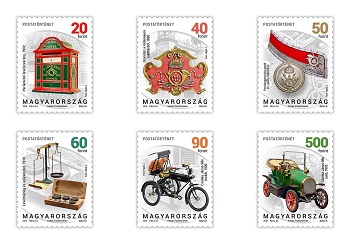
Postatörténet II. - Bélyegsor
A Magyar Posta folytatja a 2017-ben megkezdett postatörténeti forgalmi bélyegsorozat kibocsátását, aminek keretében 2018-ban is hat címlet jelenik meg. Az 20, 40, 50, 60, 90 és 500 Ft-os névértékű bélyegeket tartalmazó öntapadós sorozat Baticz Barnabás grafikusművész tervei szerint a Pátria Nyomdában készül, a forgalmi igények szerinti példányszámban. Az újdonság 2018. május 2-től kapható az elsőnapi postákon és a Filapostán, továbbá megrendelhető a Magyar Posta internetes áruházából is.
A Postatörténet forgalmi bélyegsorozat címletein a postai szolgáltatásokhoz kapcsolódó jellegzetes vagy különleges tárgyak és munkaeszközök jelennek meg a kezdetektől napjainkig. Abból a célból, hogy használatuk egyszerűbb és gyorsabb legyen, a bélyegek öntapadós változatban készülnek.
Az 20 Ft-os címleten a szabványostól eltérő, egyedi kivitelezésű levélszekrény látható, ami az 1902-ben a Parlament épületében megnyílt postahivatal számára készült. Technológia részletei megegyeznek az akkor szabványos gépi ürítésű levélszekrényekével, de a megkülönböztető sötétzöld színét és az épületre emlékeztető díszítését a kiemelt jelentőségű környezet magyarázza. Az alnyomat a levélszekrény egy felnagyított részlete.
A Magyar Királyi Posta 1896-os millenniumi kiállításra készült csarnokában elhelyezett tablóit faragott, festett oromdíszek foglalták egységes keretbe, melyeknek egy példányát a Postamúzeum őrzi, és ami a 40 Ft-os címlet fő témája. A Szent Korona szimbólummal díszített postakürt motívumot kiegészíti az elektromos hírközlésre, a távíróra és a távbeszélőre utaló villámköteg. Az alnyomatot a millenniumi kiállítási csarnokról Klösz György által készített archív fénykép részlete egészíti ki.
A posta- és távírdatisztviselők 1896-ban elrendelt szolgálati ruházata sötétkék posztóból készült. A zubbony gallérját 8 cm hosszú skarlátvörös bársonyhajtóka, paroli fedte, rajta a szolgálati rangtól és a fizetési besorolástól függően ezüst- vagy aranypaszománttal, amit ezüstözött vagy aranyozott rózsák és a posta- és távírdajelvény, azaz a postakürt és a villámok egészítettek ki. Az 50 Ft-os címleten a gallér és az egyenruha gombja jelenik meg. Az alnyomat a díszzubbony teljes gallérját és a mandzsettát díszítő, felnagyított zsinórkötést ábrázolja.
A 60 Ft-os címleten a Magyar Királyi Posta kezelésében álló, ún. kincstári postahivatalok részére szabványosított kétkarú levélmérleg tekinthető meg. Az 50 cm magas, rézserpenyőkkel ellátott mérlegeken rézsúlyokkal, grammokban mérték a levélküldemény súlyát, egészen a 2 kg-os súlyhatárig. Az alnyomatot a súlykészlet részlete illusztrálja.
A magyar postaigazgatás a világon elsőként kezdte meg a kísérleteket gépjárművek postai hasznosítására. 1900. november 19-én Budapesten levélgyűjtésre 21 háromkerekű gépjármű állt forgalomba. A 90 Ft-os címlet a Csonka János által tervezett, karburátorral felszerelt motoros levélgyűjtő tricikli 1:10 méretarányos makettjét mutatja be. Az alnyomat a tricikli motorblokkjának részletét ábrázolja.
A levélgyűjtő motoros triciklik sikerére alapozva a Magyar Királyi Posta – a Csonka János által készített prototípus sikeres próbaútját követően – 1906. január 15-én állított forgalomba további nyolc gépkocsit a főváros nagyobb forgalmú postahivatalai és pályaudvarai közötti levélszállítás és közvetítés céljából. Az 500 Ft-os címleten az említett postaautó, az alnyomaton az erről készült archív fényképfelvétel részlete látható.










